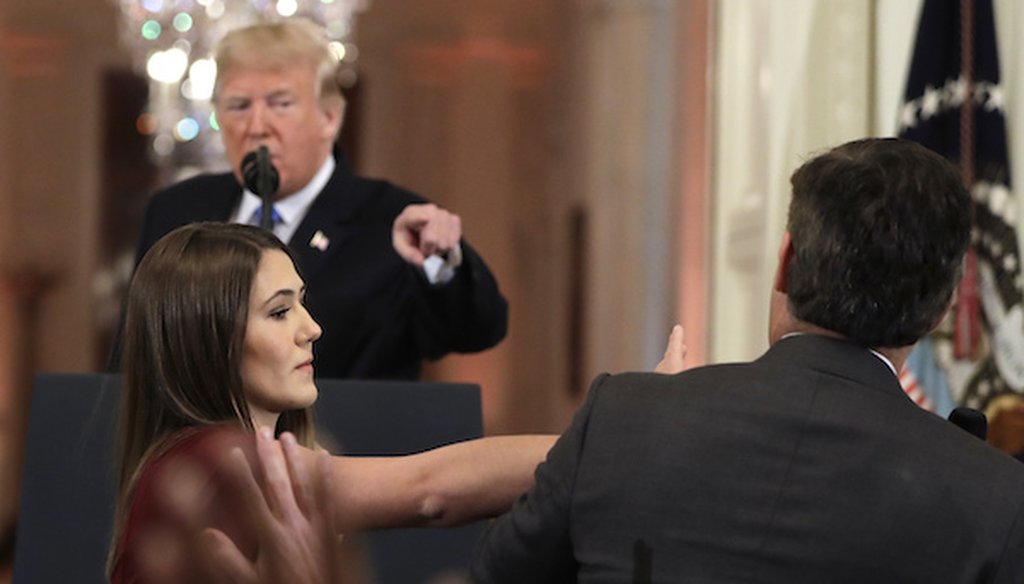Stand up for the facts!
Our only agenda is to publish the truth so you can be an informed participant in democracy.
We need your help.
I would like to contribute

As President Donald Trump points to CNN's Jim Acosta, a White House aide takes the microphone from him during a news conference in the East Room of the White House, Wednesday, Nov. 7, 2018, in Washington. (AP Photo/Evan Vucci)
The clash between President Donald Trump and the media was summed up in a viral, misleading tweet.
Hours after his post-election press conference, Press Secretary Sarah Sanders tweeted out a video in which she claims CNN White House reporter Jim Acosta "put his hands on a young woman just trying to do her job."
What happened: Acosta refused to let go of his microphone when asking questions at a press conference. A White House intern tried to take the microphone away from him. Video shows they may have touched. The Trump administration ended up taking away Acosta’s access to the White House.
But even video is subject to dispute: Users on Twitter began to say that the video Sanders shared was doctored and misleading.
We can’t tell if the video was purposefully doctored. But it seems likely that the video was distorted as it made its way to the Internet in the form of a GIF and then back to video. And, it appears the White House got the video from the conspiracy website Infowars.
What the video shows
The video replays the same sequence six times, with no sound. A White House intern reaches across Acosta’s body and grabs the microphone he is holding. He holds onto it and with his other hand, seems to karate chop the woman’s arm. She retreats.
Multiple users suggested the video was doctored to speed up Acosta’s arm motion, and thus intensify the aggression.
First, it’s important to note the footage is a mere snippet of what happened.
A full length clip of the exchange shows that Acosta first asked Trump a question about the migrant caravan. The two went back and forth. Acosta tried to follow up with another question, but Trump stopped him, "That’s enough."
At that point, a White House intern shuffled over to Acosta and tried to take the microphone from him, three times. He held onto it as he insisted on asking another question. What Acosta did with his arm -- before he said, "Pardon me, ma’am," to the intern -- had Twitter users up in arms. The audio, however, was cut from the video.
Some say he was simply gesturing and landed on an unfortunately positioned arm. Others took Sanders’ view.
Was the video doctored?
No expert we spoke to found evidence the video was intentionally sped up or slowed down. Instead, they found the quality and clarity of the original video was watered down, ultimately obfuscating what actually happened.
Paul Joseph Watson, an editor at Infowars, had tweeted out the original video. Experts matched up the footage he shared with Sanders’ video and found them identical.
Watson told Buzzfeed News he took the original footage directly from a GIF posted to the The Daily Wire’s Twitter account. He denied efforts to speed up or distort the video.
A GIF is basically a video with fewer frames -- televised video has 29.97 frames per second, while a GIF made online might be reduced to between 10 and 15 frames.
Rafael Shimunov, an activist and longtime video editor, whose tweet on the exchange went viral, overlayed the original C-SPAN video with Watson’s and found there were discrepancies, unlike with the GIF.
That, he posits, shows the video to GIF to video conversion does not make a difference. He said, "it's unlikely any process would accidentally speed up the video at the exact spot where a speed up would be most opportune to vilify the reporter."
Others agree. Shane Raymond, a journalist at Storyful, a social-media intelligence firm, told the Washington Post the edited video repeats frames that were not in the original video that exaggerate Acosta’s arm movement. Abba Shapiro, an independent video producer, told the Associated Press the frames appear altered to speed up Acosta’s arm movement
Dan Voshart, a cinematographer based in Toronto, said it boils down to bad sourcing. When Watson took the GIF, which had half the frames as a video, and then turned it into a video, the software likely blended the missing frames. The choppy images might make it look quicker.
"They took the C-SPAN video, threw away half the frames and reblended them back together to make it seem full. It’s like buying a 24 karat ring to find it was 12 karats," Voshart said. "Upload that to a video editing software, then to Twitter, and lose even more quality, and what you end up with is a conspiracy."
In other words, Sanders took a video with half the frames from the original footage to use as evidence. It’s unclear whether that’s a result of malicious inserting or removing frames, but the result is far less telling than the original clip.
Update Nov. 9, 2018: This post has been updated with additional comments from Shimunov as well as information from the Washington Post.
Our Sources
Twitter, Press Secretary Sarah Sanders, Nov. 7, 2018
Twitter, Prison Planet, Nov. 7, 2018
Twitter, Aymann Ismail, Nov. 7, 2018
Twitter, Rafael Shimunov, activist and longtime video editor, Nov. 8, 2018
Buzzfeed News, People Are Arguing About Whether This Trump Press Conference Video Is Doctored, Nov. 8, 2018
CNN, Trump clashes with Acosta in testy exchange, Nov. 8, 2018
Phone interview with Rafael Shimunov, activist and video editor, Nov. 8, 2018
Phone interview with Dan Voshart, cinematographer and animator, Nov. 8, 2018
Email interview with Hany Farid, computer science professor at Berkeley University, Nov. 8, 2018
Email interview with Al Tompkins, Poynter senior faculty, Nov. 8, 2018










































